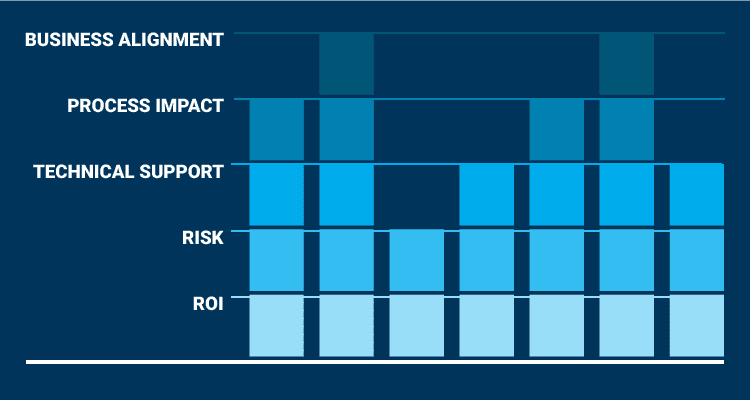
Scoring projects is an easy way to identify high value projects and push them to the front of the line, keeping your organization working on the highest priority initiatives at all times. But you might be surprised at how little of organizations are actually doing it in practice. In our latest Project and Portfolio Management Landscape Report, prioritization was cited as the second biggest challenge for organizations, consistently behind resourcing, yet increased as a challenge year over year. When asked the same organizations about scoring in particular, 24% had no formal methodology. Which begs the question: then how are projects approved?
Clearly a first-in, first-out system is not the answer when it comes to innovation. In many of these organizations, there might be someone that has a good sense of the business and what needs to get done that acts as the gatekeeper. It likely happens in a planning session or just about any time a request comes in that just can’t be passed up. But when that stops working (because it’s definitely not scalable) or emotions get involved, having a scoring system is an unbiased way to identify those projects that will best benefit the business; not just the few that stand to gain from it.
It may be tough to implement project scoring in an organization that has not historically had a methodology for it. Some individuals may even have a bubble or two burst in the process, but identifying those projects that are best for the business is undeniably the right course of action. You might be thinking, “if it’s not broken, don’t fix it” but although the process may not be “broken,” it may be ripe for improvement and benefit the whole organization in the long run.
But again, implementing scoring can be tough and it is difficult to measure the value of potential projects, especially if they are unique and there is no historical data for them. Basing a value score solely on projected financial return is not recommended because there could be upfront costs associated with the project or significant time before the return is realized, or some other unmeasurable benefit. Rather, project value should be based on criteria that weigh into an overall value score such as:
- Business alignment: how well does the project support the goals of the organization
- Impact on process: would the initiative require significant impact to existing workflows
- Technical support: does the business have the technical resources to support the initiative and how much long term benefit would there be from investing in new technology for this initiative
- Risk: what is the margin of risk in this project failing to meet expectations or being abandoned before completion
- ROI: you can not completely avoid the financial impact of a project, rather it should be a piece of the overall value score
Determining criteria is tough to agree upon for many organizations, but is a critical step in creating a scoring model. This helps organizations agree on what is most important for them, which types of projects should warrant investment and how much they are willing to leave on the table in order to better deliver the projects they deem worthy. In this process it helps to model some past projects, using some that should score off the charts, and others which were mediocre or poor, to test the value score system you have created.
If you’re implementing scoring for the first time, keep in mind it doesn’t have to be sophisticated from the start. Even a rudimentary high, medium, low is a good start to get team members accustomed to using and abiding by the value score. Once you have the process in place and ready for more, or if you find too many in the high section, you might need to add complexity to the system.
For many organizations, the agreed upon criteria are all important and serve essentially as checkboxes – a yes or no. If 4 or 5 boxes are checked for any given project, it is put in the “high” category. Those with 2-3 count as “medium,” and so on. However, that assumes that each of the criterion are equally important, which is not always (more accurately rarely) the case. To account for that, you can rank the criteria and multiply that by the point it receives. This, for example, can make something that is aligned with business goals and has the technical support needed have a higher score than a project that doesn’t impact business process and has little risk – even if it is not aligned with business goals and has no promise of ROI. For even more detail, scoring can factor both weighting and a range, in which case both the criteria and value have a range, so a project could score a 5 on the impact to process scale and a 5 on the risk to business and still have a lower score than a 3 for business alignment and 2 for technical support, given those criteria are weighted much higher. This enables a better depiction of how well the project supports a company’s goals.
Once you have a system to score projects, there will naturally become a line by which a value is too low to be approved. This can be determined by resource capacity, time constraints, budget, or a combination of these and others. There is no magic number for which a project should be approved, but knowing how projects rank in relation to other projects will help you prioritize which ones will be focused on first, and if the constraints are the issue, in which case is a whole other issue.
Scoring is simply a way to assign value to projects and keep the organization focused on the goals at hand. The better you can identify the projects that drive the business forward, the more value you can ultimately get from your investment. But scoring is not a set it and forget it system. It needs to be maintained and modified as organizational goals change or as priorities change.




